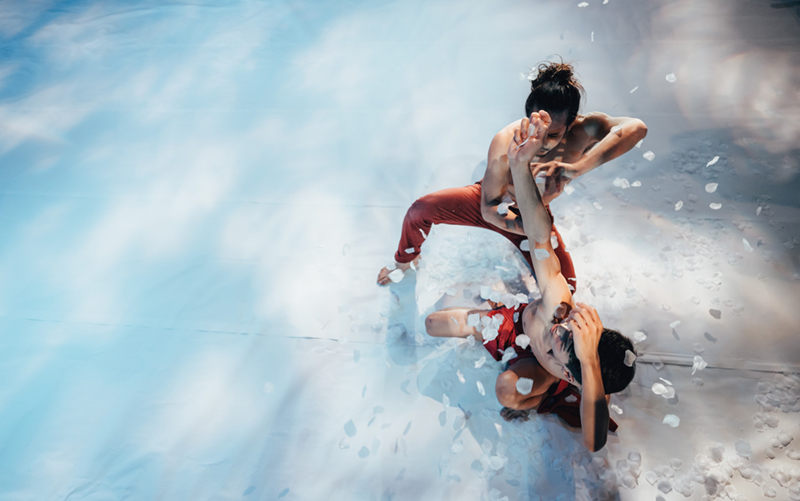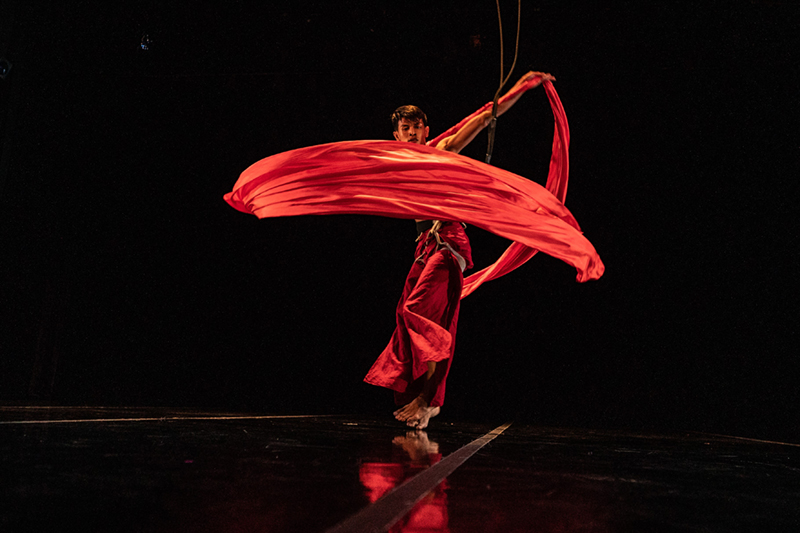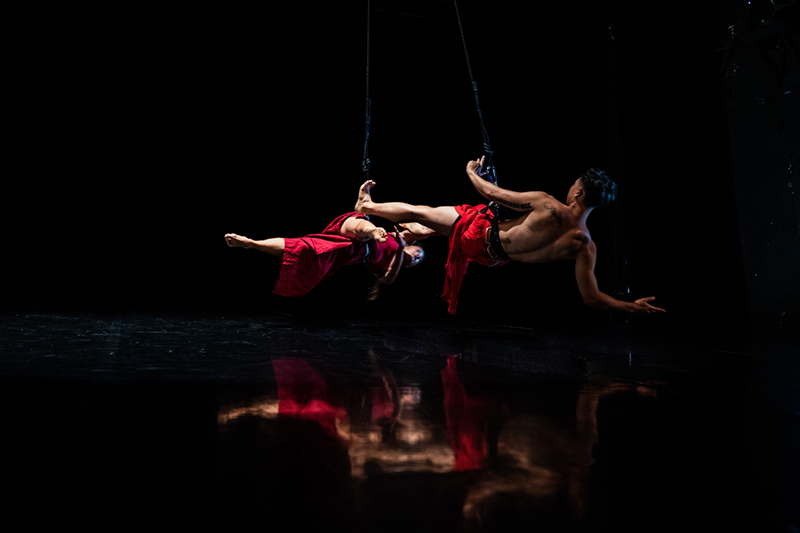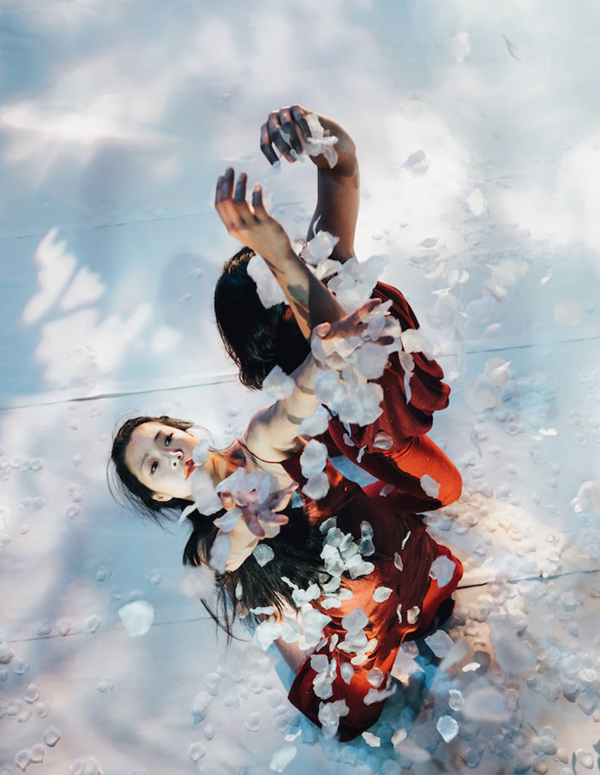A Dance to Understand Cancer
An Interview with Lenora Lee
BY EMMALY WIEDERHOLT
Inspired by the lives and experiences of breast cancer survivors, Bay Area director/choreographer Lenora Lee created In the Skin of Her Hands, a journey through healing and compassion in the face of the unknown. Here, Lenora shares her process gathering interviews with breast cancer survivors and combining it with contemporary and aerial dance as well as video projection to bring awareness to a disease that a woman is diagnosed with every two minutes.
In the Skin of Her Hands will be performed at Dance Mission Theater in San Francisco on November 1st and 2nd at 8pm, and on November 3rd at 5pm. For more information visit www.lenoraleedance.com.
Johnny Nguyen and Jory Horn, Photo by Robbie Sweeny
~~
Can you tell me a little about your dance history – what kinds of performance practices and in what contexts have shaped who you are today?
I started modern dance, improvisation, and choreography classes in college, first at City College in San Francisco and then at UCLA, where I changed my major from biochemistry to dance. I was very inspired by professors like Peter Sellars, David Gere and Victoria Marks who I studied with there. They encouraged us to dive deep into our own experiences and understanding of life, and then include that along with issues important to us within the work. Victoria Marks makes incredible portraits of individuals and communities, David Gere opened my eyes to gender inequality and the male gaze, and Peter Sellars pushed art as a social action. Over the years, I’ve been able to weave issues that I feel compelled to research with the art.
How would you generally describe your work to someone unfamiliar with it?
The pieces I create tend to be large scale, multimedia, site specific and immersive. I enjoy investigating unique spaces, especially historic locations; I’ve established a nice relationship with the California State Parks and National Park Service. I’ve done quite a few projects in historic buildings within the park systems, integrating the architecture and providing immersive experiences for the viewers. I’m compelled to understand how to create deeper connections with audience members as the performance unfolds. I’ve found in the past five years that immersive works have been quite key because the audience is in close proximity and are following the performers, so they become part of the story. They have the agency to choose whose narrative they want to see unfold and are faced with different questions such as: What is their relationship to the performer? Can they interact? Can they change the narrative? In this day of having so many options to occupy our mind-space and time, I try to understand what’s key in terms of engaging and pulling people into the issues and experiences we’re dealing with.
Can you tell me about your upcoming piece, In the Skin of Her Hands, and how the piece came about?
A lot of my previous works have been about gender inequality, immigration issues, the violence of war, and violence against women. Last May, my sister Karina was diagnosed with stage four metastatic breast cancer. It took my entire family by surprise, as we suddenly had to try to understand the disease and how we could best support her and her family. At that point, I was already committed to two or three other projects, but one of the ways I thought I could help was to do a series of interviews with my sister to document her voice as she went through this process. I wanted to know what she was learning, what adjustments she had to make for herself and for her family, how she was providing space in her life for her healing process, and also to understand the best treatments for her. That was the initiation for this research. After I finished my last big project in May, Within These Walls and Dreams of Flight, I started to dig deeper.
What has the choreographic process been like?
I tend to work collaboratively. All the dancers and I create choreography, teach it to each other, and then build chunks of material. I assemble those chunks according to the through line of the entire piece. For this project, we’re at Dance Mission Theater utilizing their three spaces – the theater as well as two dance studios. We have original music by Francis Wong and Tatsu Aoki, with live vocals as well. The multimedia design is by Olivia Ting and me.
Jory Horn, Photo by Robbie Sweeny
I put a call out through our email newsletter and social media and contacted people I knew asking to interview those currently battling cancer, specifically breast cancer, as well as loved ones and health professionals. I was able to work with a mix of folks, 32 in all. People passed the word on, and that’s how I was able to get in touch with about a third of the interviewees whom I didn’t previously know. For instance, an old coworker from my time in New York, Camilo, had been receiving my newsletters for the past 15 years. He contacted me and said his grandmother was battling breast cancer. She was 88. I flew to southern California and was able to interview her, as well as her daughter and two grandchildren (one being my friend). His sister’s brother-in-law had lymphoma, so I was able to interview him as well.
For the first month of the process, we would start every rehearsal with writing exercises on different topics. I asked the dancers to think about someone in their lives who had battled a life-threatening illness, and then envision their relationship. Other topics we wrote on included forgiveness, gratitude, redemption and healing. Then we would generate movement based on what we had written. The dancers have varied backgrounds – ballet, modern, martial arts, hip hop, break dance, aerial dance, contact improvisation, Chinese classical and folk dance. Those styles came out in the material we generated.
When I started to research what artistic elements would be included in the piece, I envisioned movement and dancing in the air. Through the suggestion of Jory Horn, one of the dance artists I work with who has experience with aerial dance, I contacted the aerial/vertical dance groups in the Bay Area. Bandaloop happened to be leading a workshop in March, so my dancer Hien Huynh and I took it and started to integrate aerial dance in the piece. Over the summer, three other dancers I work with and I took more workshops. In addition, another of my dancers, Megan Lowe, who has aerial experience is also in the piece. The aerial work integrated with on-the-ground dancing and will be part of a collage of vignettes corresponding with interview voiceovers.
Why does this piece feel relevant to produce now?
Once my sister got diagnosed last May, it blew my world open. It shook my foundation and made me realize what’s important in life. Because I know how to share narratives and histories through performance experiences, I felt compelled to do something to capture how the cancer was affecting her and everyone around her. Through the process of interviewing all these people, I became aware of how prevalent cancer is; most people know one if not many people who have been touched by cancer. However, I’ve learned so much about how everyone is affected differently; we can’t make assumptions about what illness is to a person or group of people. In trying to provide a breadth of perspectives, I hope the piece not only opens a dialogue, but provides knowledge about what cancer patients are facing so we can come together in support as a community. I believe there’s so much potential in people sharing of their thoughts, knowledge and experiences so we can somehow move forward with additional agency as a community and society. Because so many people I know have been touched by cancer, this project feels incredibly urgent. I had to create it regardless of whether funding was in place.
Lenora Lee and Hien Huynh, Photo by Robbie Sweeny
Are there specific ways that cancer survivors or patients are able to access the work?
We’re reaching out to health institutions and organizations that support cancer patients throughout the Bay Area. I had a chance to interview three different healthcare professionals, including a researcher/ oncologist at UCSF, Dr. Pamela Munster, and physical therapists Julie Wong and Karina Lee Howe. We’ve also been contacting professors in women’s studies and in the health sciences at colleges and universities throughout the Bay Area.
If people provide suggestions on other organizations to contact, we’ll do our best to take them. We’re in huge a time crunch to make the piece, publicize it, and reach out to new communities.
What do you hope audiences take away?
Personally, I’m interested to see who will come to the show and what knowledge of cancer they will bring to the table. Within the past two months, I’ve interviewed 32 voices within a sea of millions who have had cancer. I hope that the project itself will provide various perspectives and inspiration to those witnessing it.
One of my close collaborators, saxophonist Francis Wong, said to me that maybe I don’t need to feel so pressed to finish this piece for its November 1st-3rd premiere. Maybe it’s a multi-year project. Perhaps this is just the beginning of this type of research, and I’ll continue to speak to people about their challenges and battles with the disease over time. I have a feeling this is true and that I’ll be working on this for some time.
Any other thoughts?
In recent years, I’ve been trying to understand what healing looks like. How do people come to acceptance, surrender, forgiveness, reconciliation and transformation? How do they allow themselves to heal? Being able to listen to so many experiences in this regard has allowed me to look at my life differently and perhaps be gentler and more forgiving both to myself and those around me. I tend to work hard and push through life. Sometimes I don’t realize how this affects me physically and mentally and also affects those around me year after year. This drive to “succeed” and persevere can also be what can initiate illness and disease. I wonder: How can one be more accepting and forgiving of oneself and allow for surrender, introspection and regeneration?
Lynn Huang and Megan Lowe, Photo by Robbie Sweeny
~~
To learn more about In the Skin of Her Hands, www.lenoraleedance.com.




